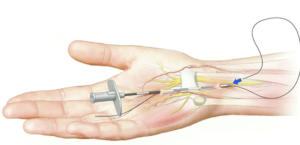Revision Carpal Tunnel Release
IF YOU NEED A REVISION CARPAL TUNNEL RELEASE, PLEASE SCHEDULE AN APPOINTMENT WITH ONE OF OUR ORTHOPEDIC SPECIALISTS AS SOON AS POSSIBLE.
What is a Revision Carpal Tunnel Release?
 Surgeons perform this procedure to address persistenting or recurring symptoms of carpal tunnel syndrome. The procedure entails reopening the carpal tunnel to alleviate pressure on the median nerve. This nerve could have been compressed anew due to the formation of scar tissue or incomplete release during the initial surgery.
Surgeons perform this procedure to address persistenting or recurring symptoms of carpal tunnel syndrome. The procedure entails reopening the carpal tunnel to alleviate pressure on the median nerve. This nerve could have been compressed anew due to the formation of scar tissue or incomplete release during the initial surgery.
Surgeons may also use this opportunity to address any new or missed sources of compression, such as anomalous muscles or fibrous bands. This procedure aims to alleviate symptoms like pain, numbness, and weakness in the hand and fingers. Following the procedure, patients typically undergo a period of rehabilitation to regain strength and mobility. Overall, this procedure is considered an effective treatment option for individuals experiencing persistent or recurrent symptoms of carpal tunnel syndrome.
Types of Revision Carpal Tunnel Release
Surgeons perform various types of this procedure whichnaddress specific issues or complications from a previous surgery. One common approach involves the open revision carpal tunnel release. This allows surgeons to make a new incision and carefully dissect through scar tissue to identify and release any remaining compression on the median nerve. Surgeons use another technique called endoscopic revision carpal tunnel release. This procedure utilizes a small camera and specialized instruments inserted through tiny incisions to visualize and release scar tissue.
Additionally, some patients may benefit from a mini-open revision carpal tunnel release, combining elements of both open and endoscopic approaches. In cases where the carpal tunnel is excessively scarred or the anatomy is altered, a more extensive procedure such as a Z-plasty or neurolysis may deem necessary. The choice of technique depends on factors such as the severity of scar tissue, the patient’s anatomy, and the surgeon’s expertise. Overall, this procedure aims to alleviate symptoms and restore normal nerve function in patients with persistent or recurrent carpal tunnel syndrome.
Rehabilitation and Recovery
Recovery from this condition entails several stages aimed at promoting healing and restoring function in the affected hand. Following surgery, patients may experience discomfort, swelling, and limited mobility. However healthcare providers manage this with pain medication and elevation of the hand. Physical therapy typically begins shortly after surgery to promote range of motion. Moreover, it allows the muscle surrounding the wrist and hand to strengthen and improve overall function.
Additionally, physicians initiate occupational therapy to help patients regain fine motor skills and perform daily tasks. As the healing process progresses, patients gradually increase their activity levels under the guidance of their healthcare providers. Adhering to the rehabilitation regimen and closely following the surgeon’s instructions is crucial for optimizing recovery. With dedication to rehabilitation and adherence to post-operative care guidelines, most patients can expect to regain full function and return to their normal activities within a few months following revision carpal tunnel release.

